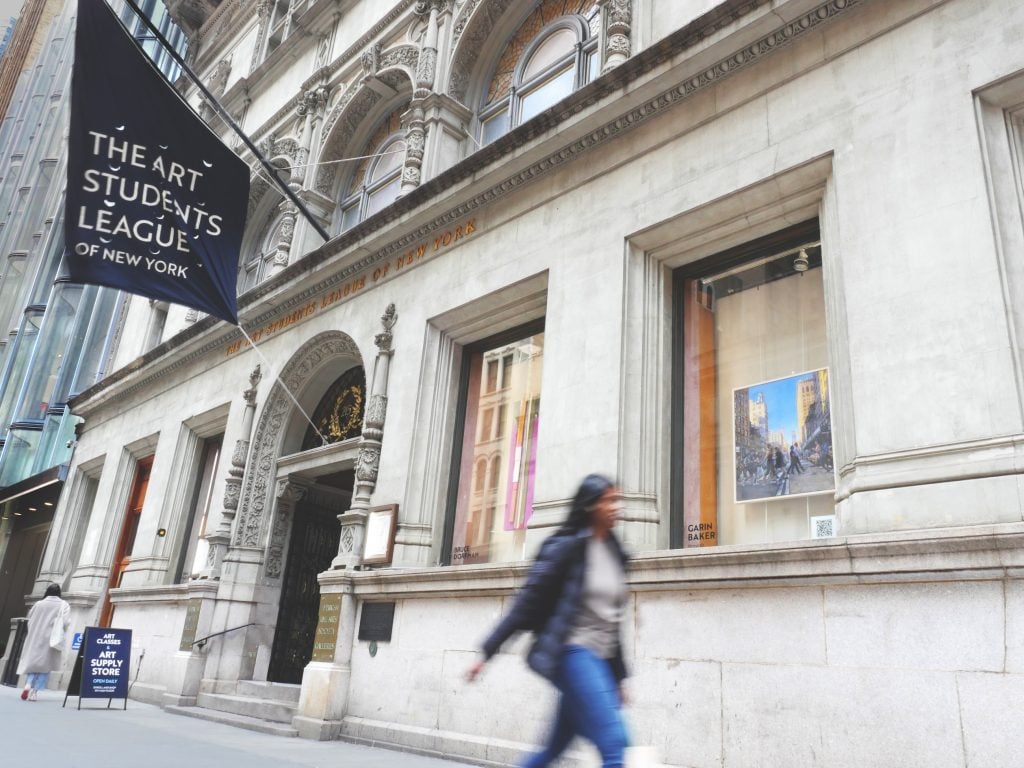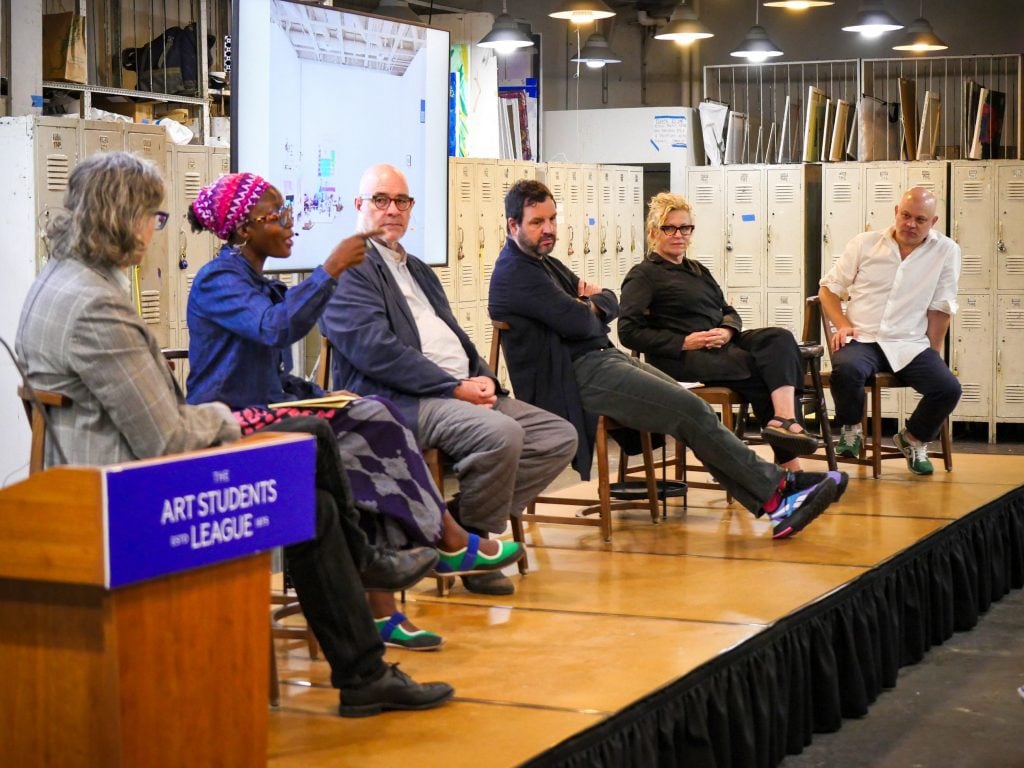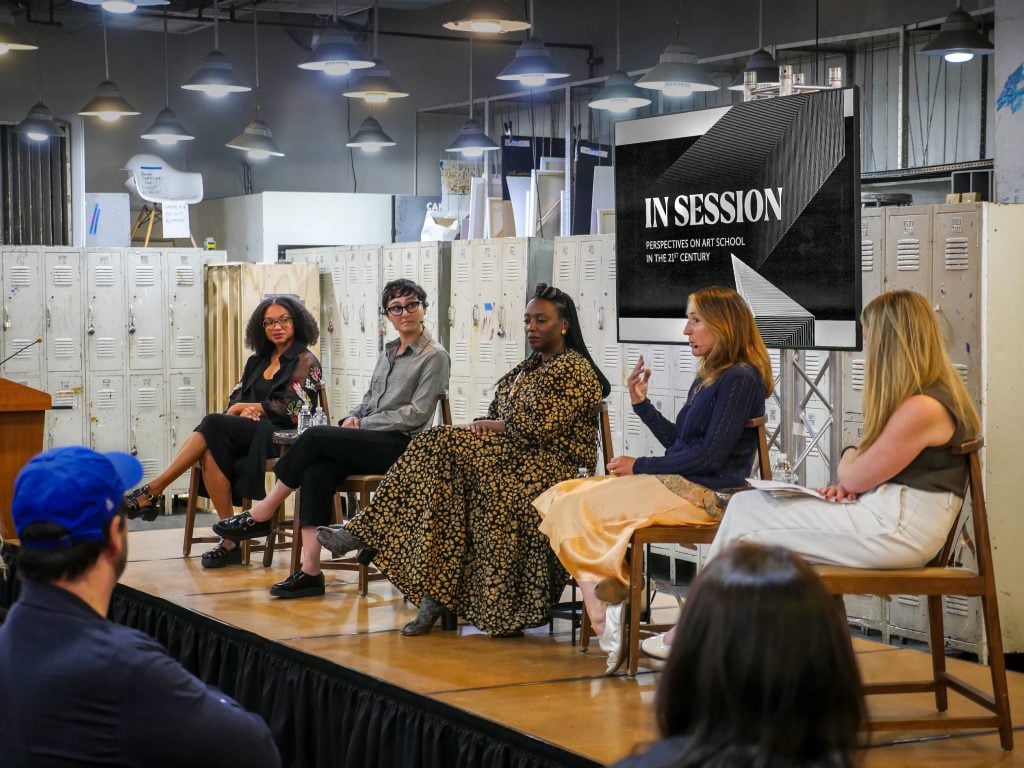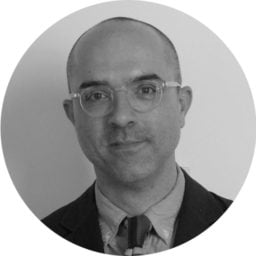Art World
MFA or Nah? 8 Key Takeaways From a Conference on Art Schools and Residencies
Hosted by the Art Students League, the day featured lively and revealing discussions.

Hundreds of artists and art-world denizens gathered in person and online on September 19 for the conference “In Session: Perspectives on Art School in the 21st Century,” where experts debated the merits of graduate degrees and pulled back the curtain on some of the country’s most prestigious residency programs. It all took place at the Art Students League, the venerable New York school that is soon to mark its 150th birthday and counts among its alumni artists from Pacita Abad, Ai Weiwei, and Romare Bearden to Isamu Noguchi, Georgia O’Keeffe, and Cy Twombly.
The morning’s panel, “Degree or Non-Degree: That’s the Question,” surveyed the same burning issue that the moderator, Artnet News national critic Ben Davis, addressed in the 2016 article “Is Getting an MFA Worth the Price?” With him on stage were professor Doug Ashford of New York’s Cooper Union, School of the Art Institute of Chicago professor Dushko Petrovich Córdova, Brooklyn College professor Patricia Cronin, assistant professor Adama Delphine Fawundu of New York’s Columbia University, and Art Students League director of programming Robert Telenick.
In the afternoon, ex-Artnet News executive editor Julia Halperin helmed the discussion “Residencies, Grants, and Other Means: A Holistic Approach to Development as an Artist.” The participants were an equally remarkable lineup of executives from top programs: Kalia Brooks, director of programs and exhibitions at New Haven, Connecticut’s NXTHVN; Kate Gavriel, director of New York’s Sharpe-Walentas Studio Program; Chiwoniso Kaitano, executive director at New Hampshire’s MacDowell; and Katie Sonnenborn, co-director of Maine’s Skowhegan.
Here are 8 key takeaways from the event.

Michael Hall, artistic and executive director of the Art Students League, introduces the morning session, with Robert Telenick and Adama Delphine Fawundu to his left. Courtesy of the Art Students League.
1. Going to art school? Don’t count on wealth and fame.
The MFA was once a terminal degree that artists earned in order to gain a teaching job, part of a kind of arms race among artists seeking a secure lifestyle. (More recently, there’s even a fine art PhD.) But these days, the panelists reported, too many MFA applicants see the degree less as a means to teaching than an investment in fame and a money-making career in the care of a major gallery.
The morning’s panelists threw cold water on that idea. Petrovich pointed out that the artist collective BFAMFAPhD found in a 2014 report that just 10 percent of two million arts graduates nationally make their primary earnings as working artists.
Fawundu decried what she called the “pick me” attitude she sees in students who are dying for access to the David Zwirners of the world, calling the mindset “dangerous.” How about instead bringing something new to the world, she asked? Higher education can put you in a room with people from all over the world who want to change things, to flip the script, she said, but she is distressed to see students instead thinking about what size painting is most salable. “What happened to exploring what kind of artist you want to be?”
Cronin agreed. “The rush to get into the market is bad,” she said, stressing that art school should be a place to find one’s voice. What’s more, she said, female graduates have more than once come to her years later to report that their male counterparts have all achieved success that still eludes the women. (She urged prospective female applicants to read the Burns Halperin Report to see how little progress has been made in recognizing female artists.)
Speakers stressed art education’s humanist dimension. No, getting an art degree won’t ensure you a job like a dental degree might, said Ashford (adding that he loves his dentist!). “But we don’t even know what an artist is,” he said. “We don’t even know what a human being is!”
2. Is the degree worth it? It depends.
Of course, there are great arguments to be made for getting an MFA. As Petrovich spelled it out, you’re entering a field of inquiry on an elevated level; at a good program, the faculty are very advanced, and you can build tremendous momentum and criticality, as well as lifelong partnerships. “If done right, it’s hard to replicate,” he said.
But of course, it all depends on what your resources are.
Asked whether he would advise someone who had been accepted to Yale (or a similarly pricey school) whether they should go, Telenick said that if they were offered a full ride or had unlimited resources, he would tell them, “I’ll help you pack.” But if not, why not use the tuition money on a more sound investment, like, say, a house? He pointed out that those thinking about art school could instead find other ways to get their work in front of people and get the feedback and frank criticism they might get in school, for example by forming a collective or an artist’s club. If you’re going to be an artist, after all, he said, you’ll be one with or without the degree.

Robert Telenick, Adama Delphine Fawundu, Doug Ashford, Dushko Petrovich Córdova, Patricia Cronin, and Ben Davis on the panel about art schools. Courtesy of the Art Students League.
3. Don’t quit your day job.
But hold on—don’t take that well-worn saying to mean what it often means.
Even if they don’t earn a living making their work, panelists agreed, artists should still make the work. Just do what generations of artists before you have done: Find a way to pay the bills that allows you to create. Artists no less revered than Adrian Piper and Carolee Schneeman gave the same advice, they said. Why not, Ashford joked, earn a living for part of the week and then make pretty things for rich people on Saturdays?
4. Public schools provide an alternative—but they’re under fire.
If you can find the right school at the right price, Cronin said, the degree can be more than worth the outlay. Her institution charges just $11,000 a year in graduate tuition, she pointed out—a fraction of what schools like Columbia, Yale, or the Rhode Island School of Design charge. You would spend that much for a small studio for a year in New York, she said, so why not spend it on tuition at Brooklyn College, where you can work alongside fellow artists who may be lifelong colleagues? For her part, she said, she attended public schools all the way and got to study with artists like Lee Bontecou and Allan D’Arcangelo.
The only problem? Public funding for higher education is under attack, Ashford said, by anti-DEI forces. He called this nothing less than “a crime against humanity.”
5. Here are the do’s and don’ts of residency applications.
In the afternoon session, things quickly got down to the nitty-gritty of how to apply for residencies, which allow artists space and time to create their work away from their everyday lives. For one thing, said Brooks, follow the friggin’ instructions. Check every box. Be succinct. Communicate with less. Oh, and don’t include your head shot on your CV, or anywhere else for that matter.
Didn’t get in, Gavriel said? Do not write a nasty email to the residency protesting your rejection. Rejected applicants are welcome to re-apply in subsequent years, panelists said, but don’t apply with the same work. Maybe use one old example to remind them who you are, and let them see the arc of your growth since then. The application committee at Skowhegan, Sonnenborn said, will recognize repeat applicants (even in the program’s blind admissions process), and may feel in a subsequent year like now is your moment.
Convince us, said Gavriel, that you’re mature enough to use the time well, but still open to learning and experimentation. And a stacked exhibition schedule may not make your case, since it may suggest you’ll be churning out inventory rather than using the time to grow.
Among the 1,000-plus residencies out there, Kaitano said, apply for the one that is right for you, rather than applying based on the prestige of the program. And if you’re already famous, that won’t help, so don’t half-ass the application.

Kalia Brooks, Kate Gavriel, Chiwoniso Kaitano, Katie Sonnenborn and Julia Halperin on the panel on artist residencies.
6. One size does not fit all.
Art school graduates lament not being taught professional development. Halperin asked whether the programs offer it, and found that the ones represented on stage range widely.
“That’s what we do,” said Brooks, explaining that NXTHVN teaches participants, for example, how to keep an inventory of their work and how to create consignment forms and invoices.
Whereas at MacDowell, Kaitano explained, you get “time and space.” What’s more, you might sit next to a legend like Lorraine O’Grady or Faith Ringgold at dinner. But you’re not going to learn how to outline a contract about gallery representation.
Sonnenborn likewise said that Skowhegan doesn’t offer training, but reported that cohorts who attended in the 1950s, ‘60s, and the ‘90s attest to ongoing relationships.
As for living experiences, Brooks and Sonnenborn pointed out that they offer two very different settings: “We are in the hood,” Brooks proclaimed, whereas Sonnenborn’s Skowhegan lies on 350 green acres, setting up a contrast: “hood versus woods.” At NXTHVN, you’re expected to interact with locals in addition to your fellows, while at Skowhegan, you’re dining, working, going to lectures, and partying with the same several dozen fellow artists.
7. Buyer beware!
Halperin asked what kind of red flags applicants should look out for. Kaitano stressed that if a program founder recently came into money, bought a farm, and set up a residency program, participants definitely won’t get the same kind of experience they will get at established programs like the ones represented on stage.
Sonnenborn added that no reputable program would require artists to leave any of their output behind; you own your own work.
8. Times change, expectations change.
Finally, does Gen Z ask for different things, Halperin asked? After it was cleared up how young Gen Zers are (27 and below), panelists agreed that as times change, their programs adjust. Kaitano nodded to the fact that her program used to be called the MacDowell Colony and that alums were called—get this—“colonists.” And while attendees used to be a fairly homogeneous group, they now better reflect what she called the “global majority.”
Gavriel, echoing the morning’s discussion, said that the younger participants are anxious about career development. Are they washed up, they ask, if they don’t get a major show by the time they’re 35? She related that Philip Pearlstein, among Sharpe-Walentas’s co-founders, would tell participants that he didn’t even decide to be an artist until he was in his 40s, telling young artists: Relax. You’ll be fine.
Sonnenborn, who reported that the average age of Skowhegan participants is 31, revealed that there’s now a licensed therapist on campus; that they cater better to special dietary needs; and that there’s a greater expectation of privacy among participants—where they used to live in triplets, fewer want roommates now.
Since NXTHVN, founded in 2019, is the youngest program of the bunch, and because residents mentor high school students, Brooks revealed with a wry laugh: “We learn one new thing every single year that will affect our organization.”





